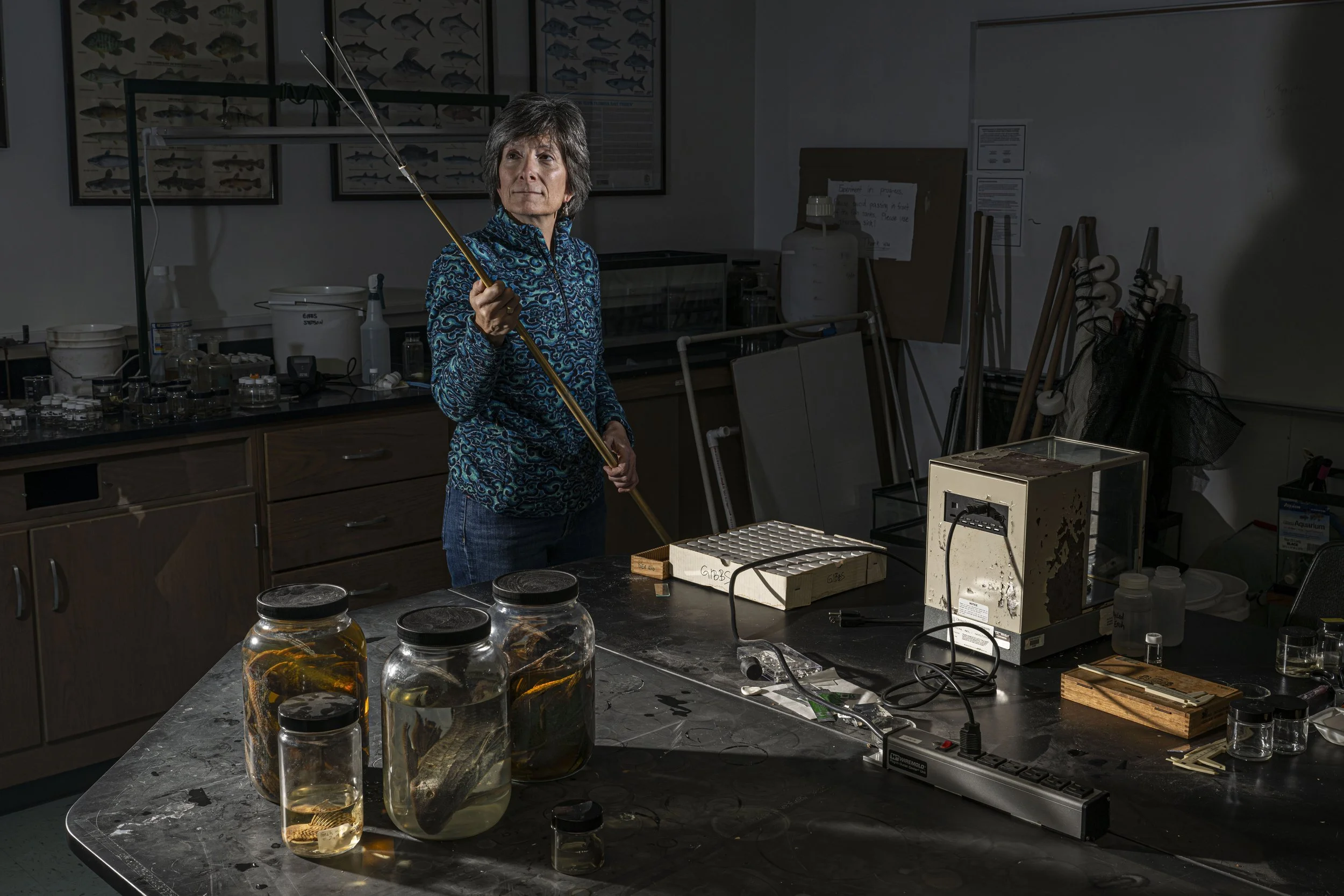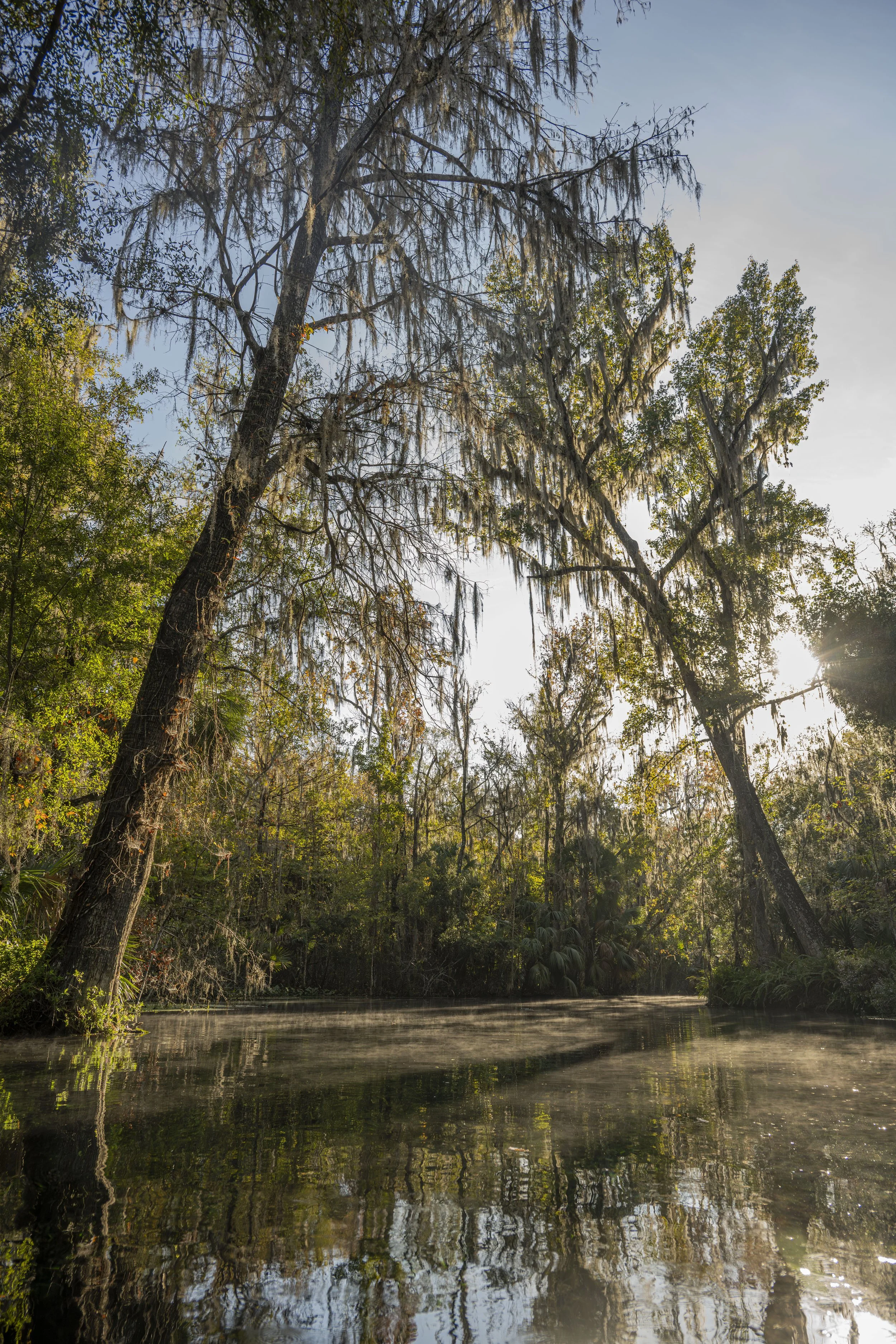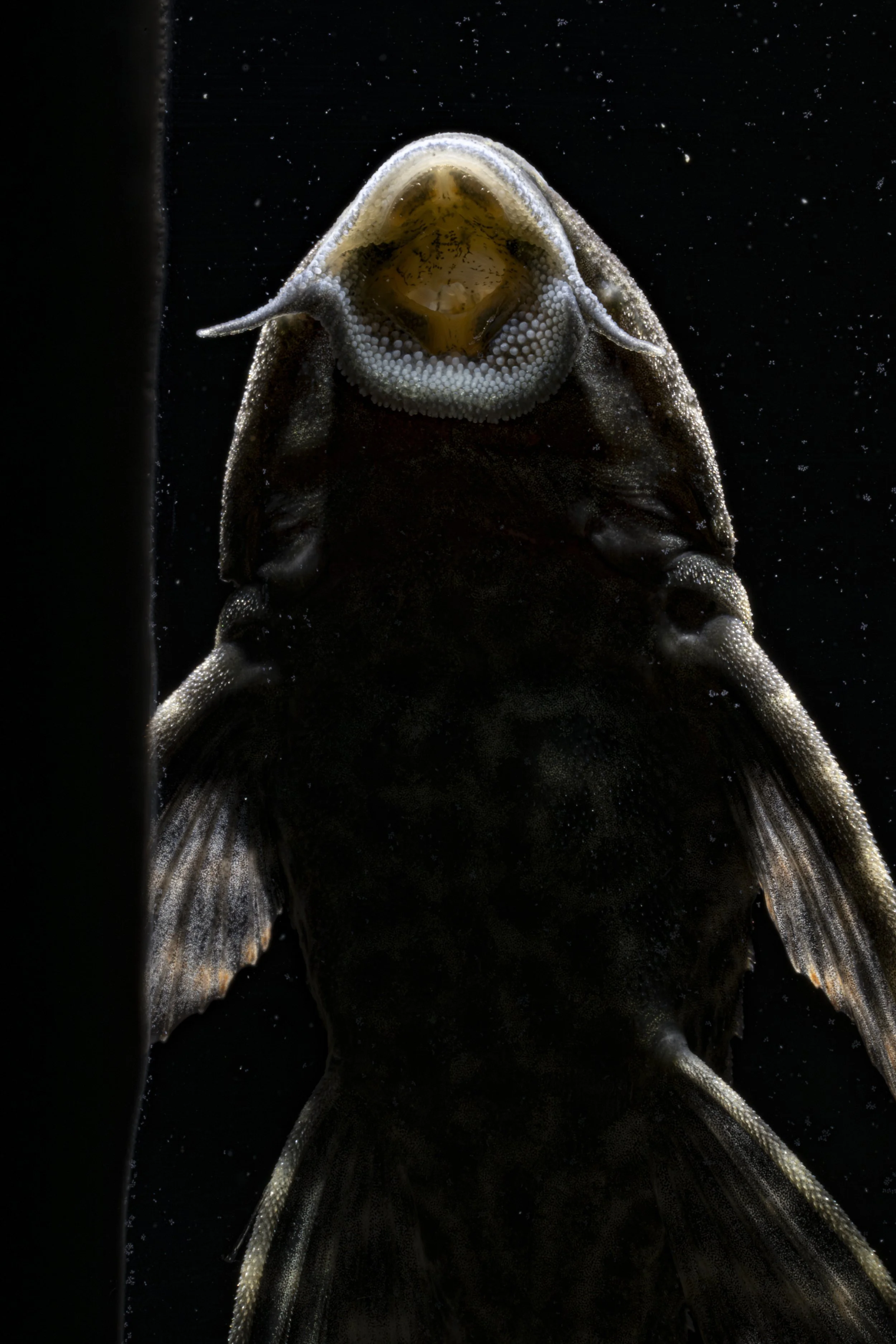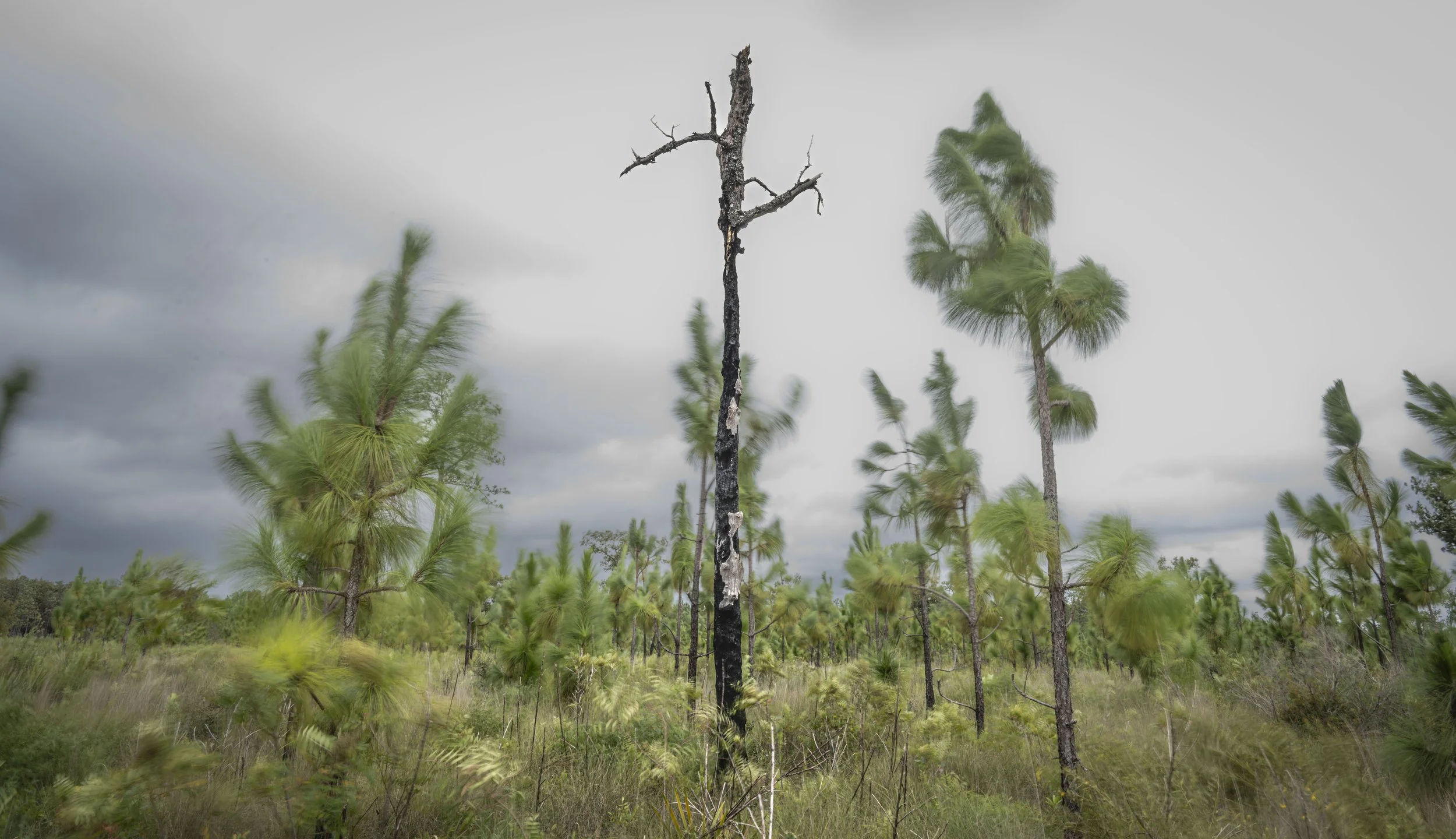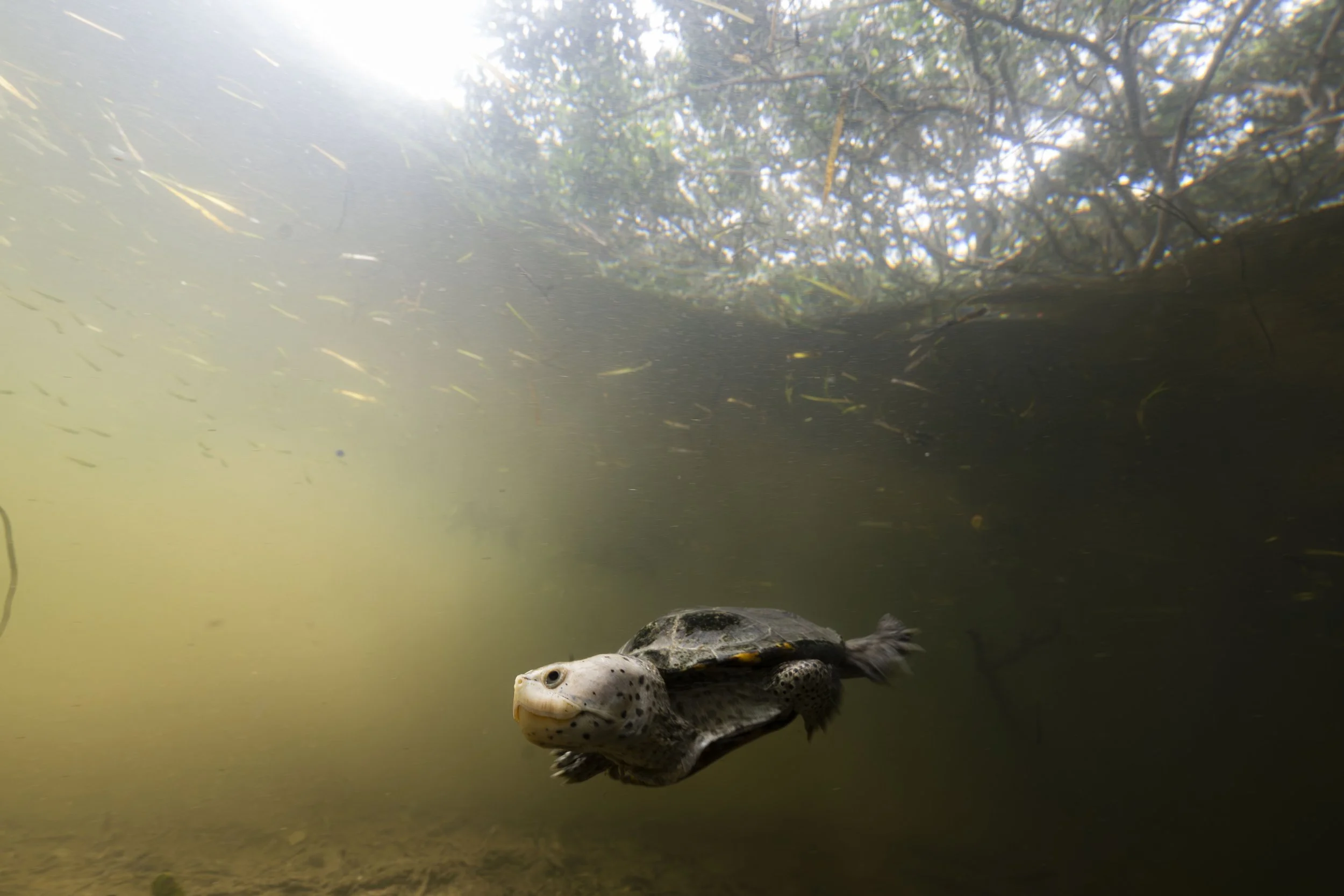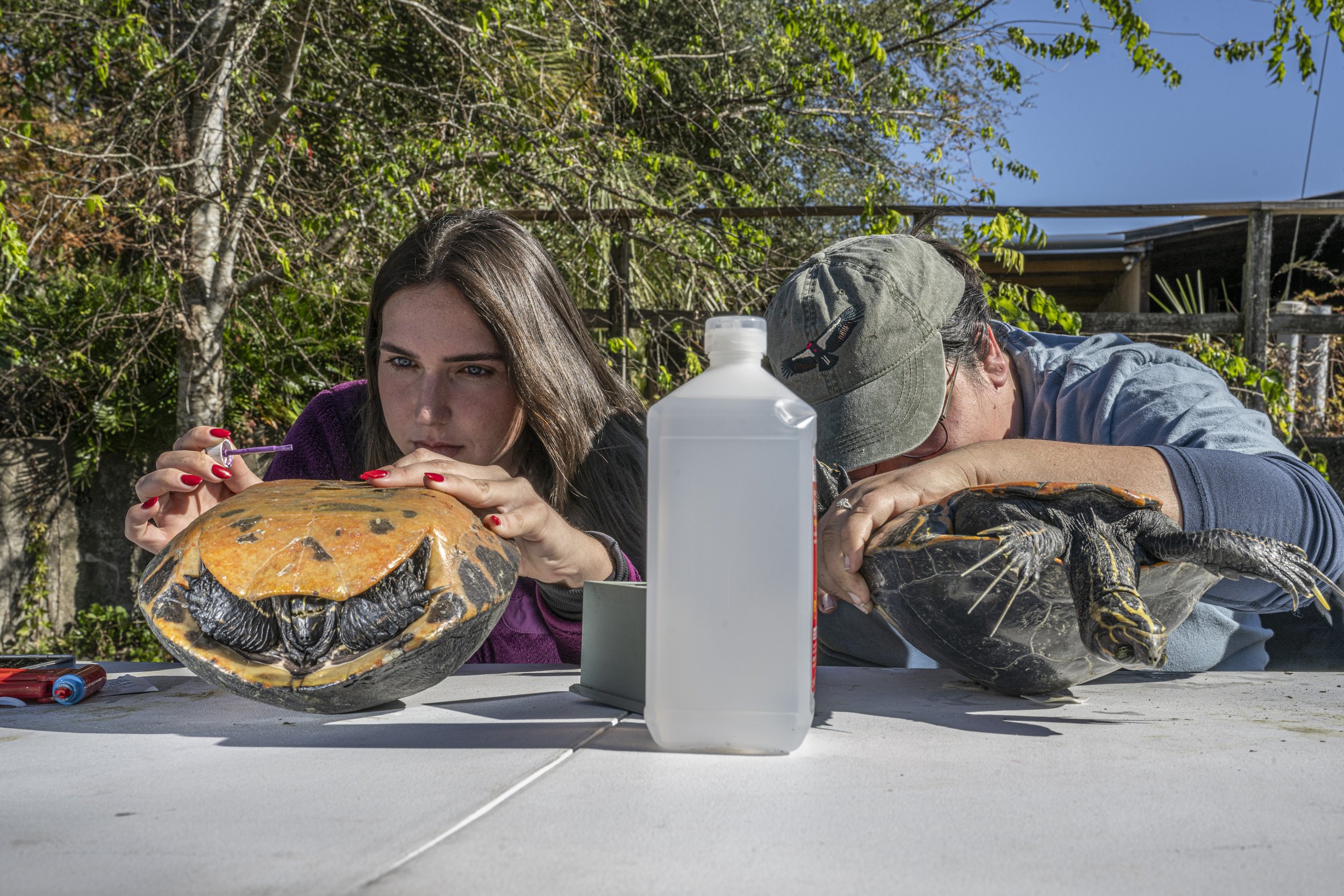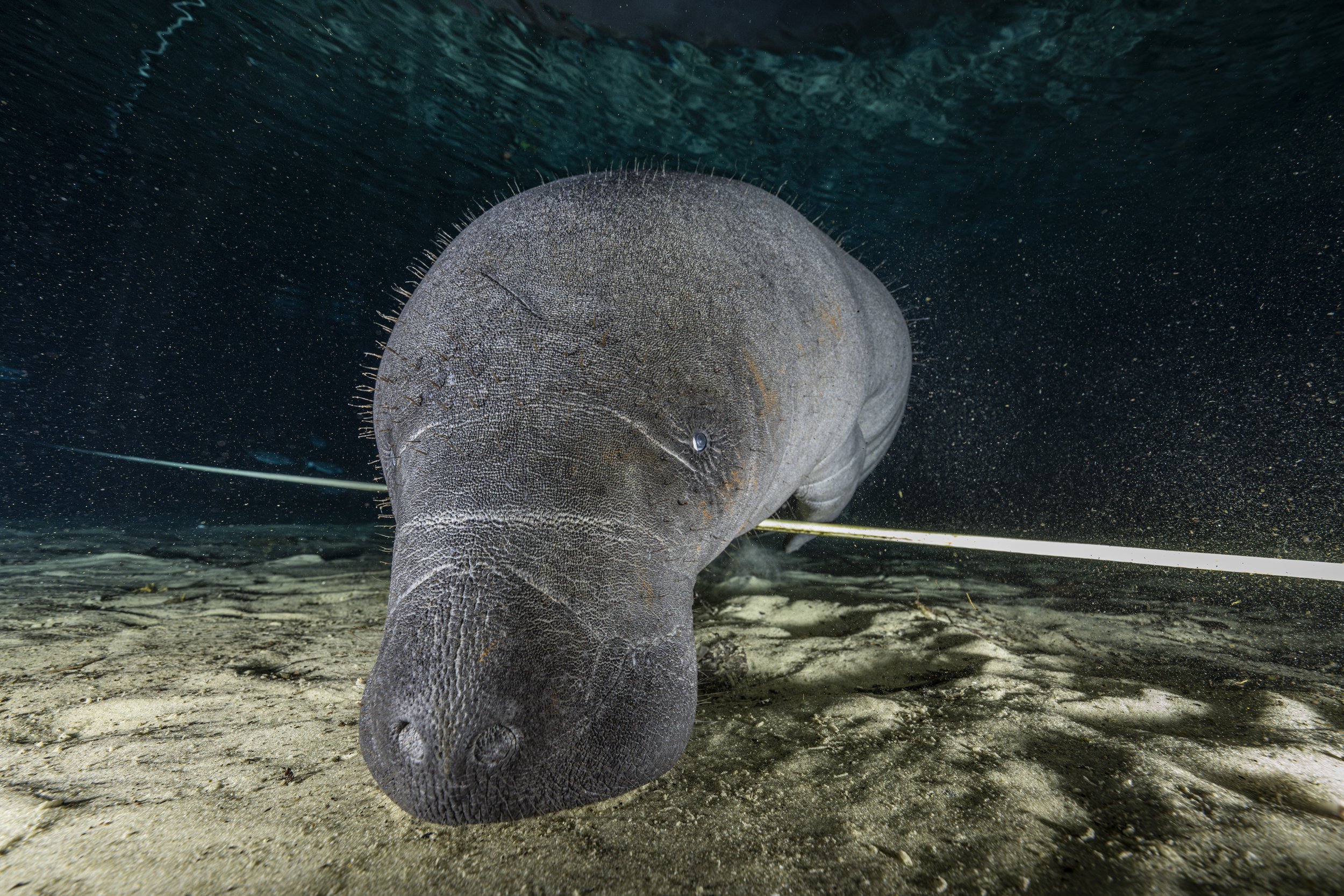GREAT PHOTOS EMERGE FROM IMPERFECTION
Compelling photos can be achieved in even the most unremarkable, strange, or unappealing conditions—here’s why I believe capturing “imperfect” photos is essential.
Dr. Melissa Gibbs, a professor at Stetson University, wields a pole spear in her student laboratory—a space cluttered with preserved fish, scattered tools, and the remnants of past experiments. Rust, dust, and faded rings from petri dishes mark the story of countless research projects. Through photography, what might seem disordered or unsightly transforms into an opportunity to reveal a deeper narrative.
Rookie Mistakes
A simple photo of the rising sun at Silver River, Florida. This kind of photography takes traditional methods to produce a nice visual, but this photo alone is not enough to tell an impactful story.
My career as a photographer didn’t begin in research labs, Florida springs, or forests at night. It started at a lifestyle publication, where the goal was to showcase a happy, healthy, sunlit world—one where everything appeared effortless and perfect. In those early assignments, I worked within those boundaries, capturing warm, golden sunrises and bright, welcoming smiles. I softened wrinkles, erased imperfections, and refined details to match my idea of what lifestyle photography should be.
But as I grew in my craft, I began to see beauty in what I once considered flaws. Every wrinkle wasn’t just a sign of age but a marker of wisdom. Every imperfection wasn’t damage, but instead, well-worn history. The more I listened to the people and places I photographed, the more I realized that these so-called imperfections told deeper, more compelling stories than any polished image ever could
In this entry of The Wayfinder Journal, my ramblings attempt to explore why the things we often avoid—rough textures, raw moments, and unpolished details—can create the most powerful images when photographed in an abstract perspective. Sometimes, what seems imperfect holds the strongest visual and emotional impact.
What is a Good Photo?
When people imagine a good photo, they often think traditionally—sunny skies, morning fog, a sharp and visually striking subject. A photo that is simply pretty. I’ve taken plenty of those myself. But while a good photo can be pretty, not every good photo has to be.
Now that I somewhat understand and continue to learn that good photos can be imperfect, I push myself to welcome the imperfect. There’s a particular feeling I get when I push the limits of a photo, almost like standing at the edge of a cliff, trying to see how far I can lean without falling. I start with a traditional shot—clean, safe, visually appealing, but nothing that would win awards. Then, I begin pushing further, experimenting with awkward angles, unconventional lighting, and unexpected compositions. It’s a balancing act of trial and error, refining each shot until something clicks.
I believe these unusual choices work because they emphasize what I consider the most important factor in photography: Dynamic Composition. You could photograph the most beautiful subject under perfect lighting, or, the nastiest subjects in the worst incandescent lights you’ve ever seen. But without a dynamic and compelling composition, neither of those images will hold the viewer’s attention. Both environments have the makings to be compelling—but it’s up to the photographer to twist, turn, and manipulate the dynamics of the subject to make that story come alive. Dynamic composition isn’t just important—it’s the foundation and priority of a great photograph and how you truly emphasize the significance of the photo and the connection to a complex story.
Creating a Dynamic Photo
By definition, dynamic imagery uses expressive visuals to capture attention and convey complex ideas. There are countless ways to achieve this, but I’ll do my best to explain what I prioritize when composing compelling images—especially with subjects and environments that are imperfectly perfect.
One of my favorite concepts in photography is the paradox of authentic manipulation—the idea that, as photographers, we have the power to shape how the world is perceived while still preserving its authenticity. Every choice we make—angle, lighting, focus, framing—alters the story we tell. It’s not about creating something false, but about emphasizing the elements that make a scene or subject truly compelling. And I can’t help emphasizing the authentic imperfections in a photo.
Flash Photography :
Don’t be afraid to switch off the lights and fire up your flashes. A cluttered foreground, a chaotic background, or even a scene that lacks depth might seem like the makings of a bad photo. But with a little light manipulation, you can guide the human eye exactly where you want it to go.
Here are two similar photos I took through glass of a juvenile invasive armored catfish, a species found throughout Florida’s freshwater ecosystems. These were captured for a National Geographic project titled These invasive pests are tormenting Florida’s manatees.
The photo on the left was my early attempt at achieving a clean, minimalist look—but the subject wasn’t suited for a vibrant, uncluttered composition. It also felt incredibly flat. I took a step back to reconnect with the emotion I wanted to convey through my photography and realized that the fish should serve as an antagonist in the story. Its sucker-like mouth is what makes it harmful to manatees, so I redirected my approach.
I cut the lights, backlit the catfish’s face, and emphasized the elements that create the most emotional and dynamic impact—the grime on the glass, the strange, wrinkled belly, the asymmetrical whiskers, and the off-kilter mouth. The fish’s features are odd, but in a way that makes the photo powerful.
Use backlighting to make key subjects glow, giving them instant priority in the frame. Experiment with shadows and directional light to carve out depth where there is none. A busy or flat image might seem like a lost cause, but with intentional lighting, you can emphasize the details that truly matter—transforming the scene into a compelling visual story. I usually keep two flashes and remote triggers with me at all times.
Crank Down Your Shutter:
During Hurricane Idalia in the Ocala National Forest, Florida, small pines bend and sway in the relentless winds, while the skeletal remains of an old tree—charred by past wildfires—stands unmoved, resilient against the storm. I love this photo because it tells the story of the forest’s past and its cycle of renewal, highlighting the vital role of natural wildfires in shaping and rejuvenating these wild landscapes. The vegitation itself was unkempt and I struggled to find a pattern, so I ripped my shutter speed wheel down to a speed that produce a motion blurred photograph with the hope of emphasizing the disruption and chaos of forceful winds.
Sometimes, a composition can feel off—empty, unbalanced, or lacking harmony between the background and foreground. Adding a bit of motion blur can help unify the frame, drawing attention to static elements while creating a more dynamic balance. A subject that might seem unremarkable on its own can take on new significance when its movement or direction is captured through blur, turning an otherwise weird frame into something visually compelling.
I achieve this through trial and error and a simple technique: increase your aperture and decrease your shutter speed. Lowering your shutter speed introduces the blur, while a higher aperture allows your camera to take in more light from the longer exposure, as well as ensures all elements in the frame remain properly focused.
Change The Angle:
In the mangrove islands off Florida’s Gulf Coast, a diamondback terrapin glides from the bank of a small island into the murky yellow waters, stirred by low tides and choppy waves. I chose to position my camera near the sandy bottom while angling upward allowing me to capture the mangroves stretching over the water—a perspective that would have been lost had I stayed at the turtle’s eye level, where only a haze of sediment-filled water would be visible. Yet, that murky water carries its own mystery when framed by the surrounding environment, as if each element in the frame is putting together a connect-the-dots story.
Most of my photos as of late are shot at a wider angle, meaning there’s plenty of space in the frame—space that needs to be filled with something, anything. When shooting from a directly horizontal or eye-level perspective, you often end up capturing only the most unremarkable parts of the environment.
It’s important to realize that you can emphasize and highlight the odd yet significant elements in a frame by tilting and twisting your camera angle to show how these elements interact with their surroundings. This ties back to the "standing on the edge of a cliff" metaphor I mentioned earlier—pushing the dynamics and abstractness of a photo as far as possible, right up to the point where it risks becoming too abstract. Essentially, you’re leaning into the oddness of an image, crafting a uniquely compelling tone through dynamic angles and intentional framing and once again: trial and error.
Embrace The Awkward:
The reality is that most people feel uncomfortable being photographed, and that awkwardness can actually be a strength rather than a limitation. Instead of trying to force a subject into looking “natural,” embrace their personality as it is—even if that means a little discomfort or stiffness. Awkwardness can open the door to some of the most genuine and intriguing photo opportunities.
Turtle surveyors Avery Rust and Emanuela Torres-Marquis carefully paint markers on collected turtles under permit through the Florida Springs Institute at Silver Springs, FL. Not everyone is eager to be photographed—you can sense the discomfort in their posture and expression when you approach with a camera. Yet, I’ve always found peace in capturing those raw, unfiltered moments—the awkwardness, the quirks—like a shy researcher ducking under their hat while painting a marker on an upside-down turtle.
If someone struggles to smile, don’t force it. Sometimes, a neutral expression carries far more weight and fits the frame better. At the same time, take on the mindset of a fly on the wall, sneaking around to capture authentic moments—but don’t be afraid to get up close and personal, either. Your presence in an environment may introduce some initial awkwardness, but lean into it rather than resisting it.
Use the way people naturally position themselves, react, or move within the frame as a tool to capture their real emotions and energy. It’s hard to explain, but it’s almost like riding a wave—going with the flow, feeling the energy of the moment, and recognizing the beauty in those imperfect, unfiltered interactions.
Lastly, Start Taking Imperfect Photos
At its core, photography isn’t about capturing perfection—it’s about capturing compelling and dynamic composition. The most striking images often emerge from the moments and details we’re conditioned to overlook. The wrinkles, the awkwardness, the unconventional angles, the so-called imperfect frames—all of these elements hold an undeniable authenticity that polished perfection simply can’t replicate.
By embracing imperfection, pushing creative boundaries, and allowing a photo to breathe in its rawest form, we create visuals that aren’t just aesthetically pleasing but emotionally compelling. Dynamic composition, light manipulation, and unconventional perspectives all play a role in turning the ordinary into something extraordinary. But at the end of the day, the real magic happens when we stop trying to force an image into an expected mold and instead let the subject, environment, and energy of the moment guide us.
So, the next time you’re shooting, challenge yourself to lean into the so-called flaws. Look for the tension in a frame, the unease in a subject, the unexpected beauty in the imperfect. You might just find that the “ugliest” photos are the ones that stick with you the longest.
In the barren expanse of Silver Glen Springs, Florida—an ecosystem degraded by habitat loss from heavy human and boating activity—a hairy, wrinkled manatee stirs up a cloud of sand as it drifts across the boundary separating a protected restoration zone from the unrestored spring run. While some may find backscatter visually unappealing, I see the suspended sand as a revealing story to the spring’s current state—both a great visual and a reminder of its fragility.

